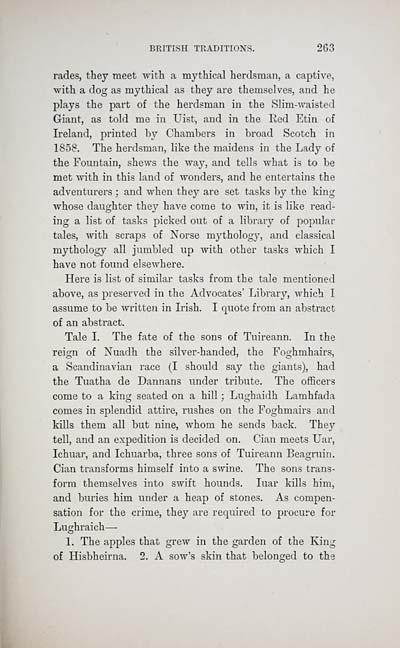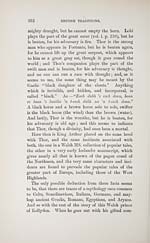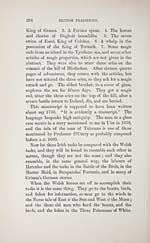Download files
Complete book:
Individual page:
Thumbnail gallery: Grid view | List view

BRITISH TRADITIONS. 263
rades, they meet with a mythical herdsman, a captive,
with a dog as mythical as they are themselves, and he
plays the part of the herdsman in the Slim-waisted
Giant, as told me in Uist, and in the Eed Etin of
Ireland, printed by Chambers in broad Scotch in
1858. The herdsman, like the maidens in the Lady of
the Fountain, shews the way, and tells what is to be
met with in this land of wonders, and he entertains the
adventurers ; and when they are set tasks by the king
whose daughter they have come to win, it is like read-
ing a list of tasks picked out of a library of popular-
tales, with scraps of Norse mythology, and classical
mythology all jumbled up with other tasks which I
have not found elsewhere.
Here is list of similar tasks from the tale mentioned
above, as preserved in the Advocates' Library, Avhich I
assume to be written in Irish. I quote from an abstract
of an abstract.
Tale I. The fate of the sons of Tuireann. In the
reign of Nuadh the silver-handed, the Foghmhairs,
a Scandinavian race (I should say the giants), had
the Tuatha de Dannans under tribute. The officers
come to a king seated on a hill ; Lughaidh Lamhfada
comes in splendid attire, rushes on the Foghmairs and
kills them all but nine, whom he sends back. They
tell, and an expedition is decided on. Cian meets Uar,
Ichuar, and Ichuarba, three sons of Tuireann Beagruin.
Cian transforms himself into a swine. The sons trans-
form themselves into swift hounds. Iuar kills him,
and buries him under a heap of stones. As compen-
sation for the crime, they are required to procure for
Lughraich —
1. The apples that grew in the garden of the King
of Hisbheirna. 2. A sow's skin that belonged to the
rades, they meet with a mythical herdsman, a captive,
with a dog as mythical as they are themselves, and he
plays the part of the herdsman in the Slim-waisted
Giant, as told me in Uist, and in the Eed Etin of
Ireland, printed by Chambers in broad Scotch in
1858. The herdsman, like the maidens in the Lady of
the Fountain, shews the way, and tells what is to be
met with in this land of wonders, and he entertains the
adventurers ; and when they are set tasks by the king
whose daughter they have come to win, it is like read-
ing a list of tasks picked out of a library of popular-
tales, with scraps of Norse mythology, and classical
mythology all jumbled up with other tasks which I
have not found elsewhere.
Here is list of similar tasks from the tale mentioned
above, as preserved in the Advocates' Library, Avhich I
assume to be written in Irish. I quote from an abstract
of an abstract.
Tale I. The fate of the sons of Tuireann. In the
reign of Nuadh the silver-handed, the Foghmhairs,
a Scandinavian race (I should say the giants), had
the Tuatha de Dannans under tribute. The officers
come to a king seated on a hill ; Lughaidh Lamhfada
comes in splendid attire, rushes on the Foghmairs and
kills them all but nine, whom he sends back. They
tell, and an expedition is decided on. Cian meets Uar,
Ichuar, and Ichuarba, three sons of Tuireann Beagruin.
Cian transforms himself into a swine. The sons trans-
form themselves into swift hounds. Iuar kills him,
and buries him under a heap of stones. As compen-
sation for the crime, they are required to procure for
Lughraich —
1. The apples that grew in the garden of the King
of Hisbheirna. 2. A sow's skin that belonged to the
Set display mode to: Large image | Transcription
Images and transcriptions on this page, including medium image downloads, may be used under the Creative Commons Attribution 4.0 International Licence unless otherwise stated. ![]()
| Early Gaelic Book Collections > Matheson Collection > Popular tales of the west Highlands > Volume 4 > (279) |
|---|
| Permanent URL | https://digital.nls.uk/81490405 |
|---|
| Description | Volume IV. |
|---|---|
| Shelfmark | Mat.77 |
| Additional NLS resources: | |
| Attribution and copyright: |
|
| Description | Items from a collection of 170 volumes relating to Gaelic matters. Mainly philological works in the Celtic and some non-Celtic languages. Some books extensively annotated by Angus Matheson, the first Professor of Celtic at Glasgow University. |
|---|
| Description | Selected items from five 'Special and Named Printed Collections'. Includes books in Gaelic and other Celtic languages, works about the Gaels, their languages, literature, culture and history. |
|---|

